Tony McSean
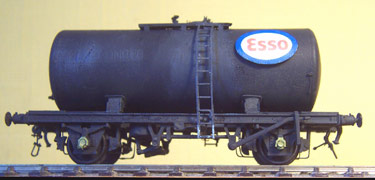 The standard Airfix Esso tanks, originally built to OO standards over 30 years ago, and now retrieved from their box and given the full Geoff Kent treatment.
The standard Airfix Esso tanks, originally built to OO standards over 30 years ago, and now retrieved from their box and given the full Geoff Kent treatment.
Disconcertingly, they had become self-dismantling with the passage of time and the full train of 14 tanks survived the reconstruction (apart from one that was in the paint stripper when unexpected guests arrived and deconstructed itself into paste, and one I cannibalised).
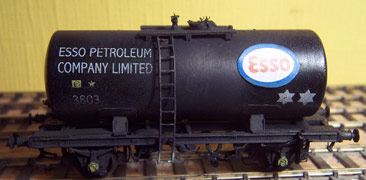 The details of what I did to them are all in Geoff's book. The etched ladders were a devil to get right and soldering up the drain cocks was a finger-scarring experience but otherwise the upgrading was an enjoyable and satisfying job.
The painting and weathering is my first serious venture into airbrushing. The transfers for the lettering and branding are home made (although the CCT products are better and very good value) and the pictures were taken before Bill Bedford produced his etches for the Esso logo - I immediately replaced my styrene versions and the improvement is marked.
The details of what I did to them are all in Geoff's book. The etched ladders were a devil to get right and soldering up the drain cocks was a finger-scarring experience but otherwise the upgrading was an enjoyable and satisfying job.
The painting and weathering is my first serious venture into airbrushing. The transfers for the lettering and branding are home made (although the CCT products are better and very good value) and the pictures were taken before Bill Bedford produced his etches for the Esso logo - I immediately replaced my styrene versions and the improvement is marked.
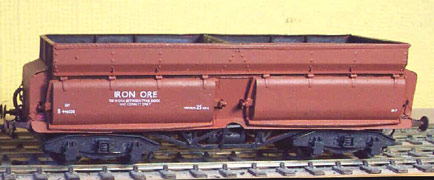 These Bradwell kits were constructed more or less as per the instructions. Building them took a long time but the quality of the design, production and instructions made the job a pleasure from beginning to end.
These Bradwell kits were constructed more or less as per the instructions. Building them took a long time but the quality of the design, production and instructions made the job a pleasure from beginning to end.
The only slightly tricky bits were
(a) getting the apex of the lateral centre divider to sit below the level of the sides (this was just a fiddle )
(b) soldering on the ribs at the top of each end which even using an RSU I found had me reaching for the
 colourful language and some replacement brass strip.
colourful language and some replacement brass strip.
Otherwise they were great. The lettering is home-made and the inside is brush painted with metalcote gunmental and buffed up with a cotton bud.
The Hurst snowploughs are also in as-new condition. The kits aren't too bad and sit on Gibson wheels of prototypically differing diameter.
The sharp end of the blade looked like it would be difficult to get right but wasn't - and both these units have tidier blades than the in-service pictures I've seen of the prototypes so probably should be half unsoldered. The real catch is where the blade section meets the cab, which has to be smooth and was a devil to get right. It's still not perfect but the chevrons distract the eye (I tell myself).
Chevrons and lettering are home-made decals. The paint job was the other real catch. The two ploughs have had 5 paint jobs between them - partly incompetence but mostly because it's not easy. Look closely and you'll see imperfections and retouching, but it was that or alcoholism, blindess, insanity and death.
Every one of these units seems to have its own variation of livery, so I kept these plain and as retro as feasible for something not introduced until 1965. PS The handrails are now straight.
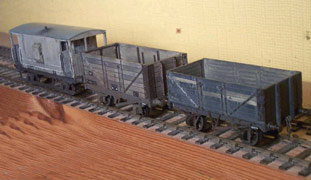 Finally some mineral wagons.
Finally some mineral wagons.
They include kits from Parkside and Slaters and
RTR from Bachmann and Trix. There's nothing very special in their construction and they have been detailed to varying standards of completeness as I have learned to ape a better class of modeller. The differences in finish of the wooden wagons also show attempts at different methodologies of arriving at raw wood. By far the most wearing of these
was "the paint it up like new wood and cover with about 87 washes of Humbrol LNER wagon grey".. Worked up to a pint, but the brain damage from inhaling all those thinners is there to see today!
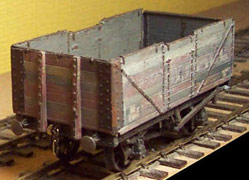 |
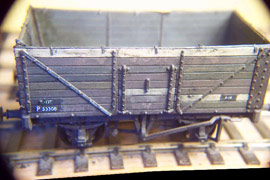 |
 |
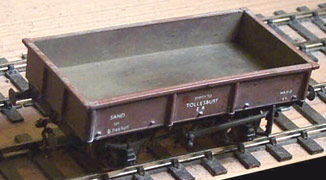 |

 Return to Members Portfolio
Return to Members Portfolio